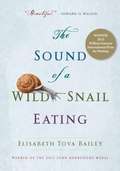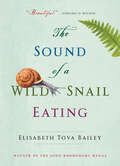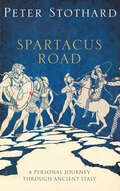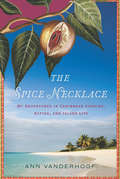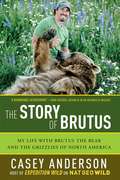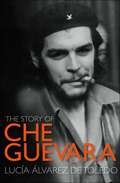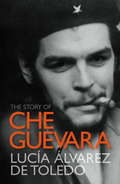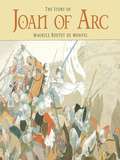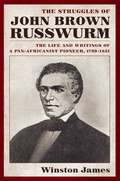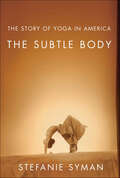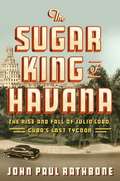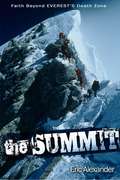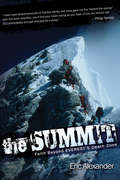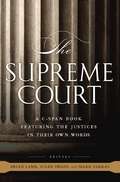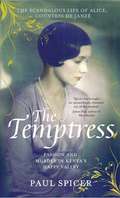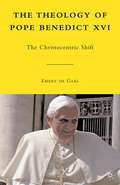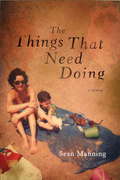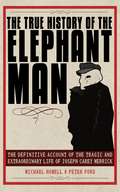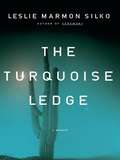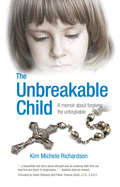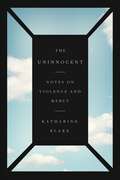- Table View
- List View
The Sound Of A Wild Snail Eating
by Elisabeth Tova BaileyIn a work that beautifully demonstrates the rewards of closely observing nature, Elisabeth Bailey shares an inspiring and intimate story of her uncommon encounter with a Neohelix albolabris --a common woodland snail. <P><P> While an illness keeps her bedridden, Bailey watches a wild snail that has taken up residence on her nightstand. As a result, she discovers the solace and sense of wonder that this mysterious creature brings and comes to a greater under standing of her own confined place in the world. <P> Intrigued by the snail's molluscan anatomy, cryptic defenses, clear decision making, hydraulic locomotion, and mysterious courtship activities, Bailey becomes an astute and amused observer, providing a candid and engaging look into the curious life of this underappreciated small animal. <P> Told with wit and grace, The Sound of a Wild Snail Eating is a remarkable journey of survival and resilience, showing us how a small part of the natural world illuminates our own human existence and provides an appreciation of what it means to be fully alive.
The Sound of a Wild Snail Eating
by Elisabeth Tova BaileyIn a work that beautifully demonstrates the rewards of closely observing nature, Elisabeth Tova Bailey shares an inspiring and intimate story of her encounter with a Neohelix albolabris—a common woodland snail. While an illness keeps her bedridden, Bailey watches a wild snail that has taken up residence on her nightstand. As a result, she discovers the solace and sense of wonder that this mysterious creature brings and comes to a greater understanding of her own place in the world. Intrigued by the snail’s molluscan anatomy, cryptic defenses, clear decision making, hydraulic locomotion, and courtship activities, Bailey becomes an astute and amused observer, offering a candid and engaging look into the curious life of this underappreciated small animal. The Sound of a Wild Snail Eating is a remarkable journey of survival and resilience, showing us how a small part of the natural world can illuminate our own human existence, while providing an appreciation of what it means to be fully alive.
The Spartacus Road: A Personal Journey Through Ancient Italy
by Peter StothardA classicist retraces the ancient journey taken by the Spartacus and his army of rebels through Italy in the first century BC Gladiator War.In the final century of the first Roman Republic, an army of slaves undertook a historic revolt. Led by the gladiator Spartacus, its success was something no one before had ever known. The Spartacus Road is the route along which this rebel army outfought the Roman legions between 73 and 71BC, bringing both fears and hopes that have never wholly left the modern mind. It is a road that stretches through 2,000 miles of Italian countryside and out into 2,000 years of world history.In this inspiring and original memoir, the former editor of The Times, Peter Stothard, takes us on an extraordinary journey. The result is a book like none other: at once a journalist’s notebook, a classicist’s celebration, a survivor’s record of a near fatal cancer and the history of a unique and brutal war. As he travels along the Spartacus road—through the ruins of Capua to Vesuvius and the lost Greek cities of the Italian south—Stothard illuminates conflicting memories of times ancient and modern, breathing new life into one of the greatest stories of the ages.
The Spice Necklace: My Adventures in Caribbean Cooking, Eating, and Island Life
by Ann VanderhoofThe author of An Embarrassment of Mangoes offers &“a mouthwatering slice of Caribbean culture&” in this blend of travel memoir and cookbook (New York Post). While sailing around the Caribbean, Ann Vanderhoof and her husband Steve track wild oregano-eating goats in the cactus-covered hills of the Dominican Republic, gather nutmegs on an old estate in Grenada, make searing-hot pepper sauce in a Trinidadian kitchen, cram for a chocolate-tasting test at the University of the West Indies, and sip moonshine straight out of hidden back-country stills. Along the way, they are befriended by a collection of unforgettable island characters: Dwight, the skin-diving fisherman who always brings them something from his catch and critiques their efforts to cook it; Greta, who harvests sea moss on St. Lucia and turns it into potent Island-Viagra; sweet-hand Pat, who dispenses hugs and impromptu dance lessons along with cooking tips in her Port of Spain kitchen. Back in her galley, Ann practices making curry like a Trini, dog sauce like a Martiniquais, and coo-coo like a Carriacouan. And for those who want to take these adventures into their own kitchens, she pulls 71 delicious recipes from the stories she tells, which she places at the end of the relevant chapters. The Spice Necklace is a wonderful escape into a life filled with sunshine (and hurricanes), delicious food, irreplaceable company, and island traditions.
The Story of Brutus: My Life with Brutus the Bear and the Grizzlies of North America
by Casey AndersonThe heart-warming story of the incredible friendship between National Geographic star Casey Anderson and an 800-pound grizzly bear named Brutus. Casey Anderson, the host of National Geographic's Expedition Grizzly, met a month-old bear cub in a wildlife preserve in 2002, whom he affectionately named Brutus. Little Brutus was destined to remain in captivity or, more likely, even euthanized due to overpopulation at the preserve. Anderson, already an expert in animal rescue and rehabilitation, just could not let that happen to Brutus, who looked like a "fuzzy Twinkie." From the beginning it was clear something special existed between the two. And so, Anderson built the Montana grizzly encounter in Bozeman, Montana, especially for Brutus, so that he, and others like him, could grow up "being a bear." And so the love story began. When together, Anderson and Brutus will wrestle, swim, play, and continue to act as advocates for grizzly protection and education, be it through documentaries like Expedition Grizzly, appearances on Oprah or Good Morning America, or in this inspiring book, which promises to be an intimate look into Anderson's relationship with Brutus and a call to action to protect these glorious animals and the natural world they live in. The Story of Brutus proves that love and friendship knows no bounds and that every care must be taken to protect one of nature's noblest creatures.
The Story of Che Guevara
by Lucia Alvarez de ToledoChe Guevara is something of a symbol in the West, a representative of Sixties counterculture and the face adorning the T-shirts of a million student radicals. But in the rest of the world he is something else: a charismatic revolutionary who redrew the political map of Latin America and gave hope to those resisting colonialism everywhere.Lucia Alvarez de Toledo comes from the same social milieu as Che Guevara; born and raised in Buenos Aires, she was at school while he attended university, and then as a journalist she closely followed his meteoric political rise. As a result she is able to put him into context like few others among his biographers, dispelling numerous popular misconceptions and revealing aspects to his life which have been missed before. Based on interviews with Che's family and those who knew him intimately, this is an accessible biography that concentrates on the man rather than the icon. With the political developments in Latin America in the twenty-first century, Guevara's influence can be seen to be even greater than it was during his lifetime.
The Story of Che Guevara
by Lucía Álvarez de Toledo Lucía Álvarez ToledoAn accessible biography of one of the most influential figures of recent times based on new, original research.Che Guevara is something of a symbol in the West. But for the rest of the world he is different: a charismatic revolutionary who redrew the political map of Latin America and gave hope to those resisting colonialism everywhere. In The Story of Che Guevara Lucía Álvarez de Toledo follows Che from his birth in Rosario and his early years in his parent's maté plantation, to his immortal motorcycle journeys across South America, his role at the heart of Castro's new Cuban government, and through to the unforgiving jungle that formed the backdrop to his doomed campaigns in the Congo and Bolivia. Based on interviews with Che's family and those who knew him intimately, this is an accessible biography that concentrates on the man rather than the icon. With the political developments in Latin America in the twenty-first century, his influence can be seen to be even greater than it was during his lifetime and The Story of Che Guevara is a perfect introduction to an extraordinary man.
The Story of Che Guevara
by Lucía Álvarez de Toledo Lucía Álvarez ToledoAn accessible biography of one of the most influential figures of recent times based on new, original research.Che Guevara is something of a symbol in the West. But for the rest of the world he is different: a charismatic revolutionary who redrew the political map of Latin America and gave hope to those resisting colonialism everywhere. In The Story of Che Guevara Lucía Álvarez de Toledo follows Che from his birth in Rosario and his early years in his parent's maté plantation, to his immortal motorcycle journeys across South America, his role at the heart of Castro's new Cuban government, and through to the unforgiving jungle that formed the backdrop to his doomed campaigns in the Congo and Bolivia. Based on interviews with Che's family and those who knew him intimately, this is an accessible biography that concentrates on the man rather than the icon. With the political developments in Latin America in the twenty-first century, his influence can be seen to be even greater than it was during his lifetime and The Story of Che Guevara is a perfect introduction to an extraordinary man.
The Story of Joan of Arc
by Gerald Gottlieb Maurice Boutet de MonvelHer story is legendary, but it happens to be true: nineteen-year-old Joan of Arc led armies into battle during the Hundred Years War and helped liberate France from English domination. One of the most famous children's books ever published, this elegant work recounts Joan's wondrous transformation from peasant girl to military commander to Christian saint and martyr. Generations of artists and writers from around the world have drawn inspiration from Joan's life, and she remains among the best-known historical figures of the Middle Ages. Maurice Boutet de Monvel's simple but moving retelling of her story features a series of imaginative illustrations that won the artist international fame. All forty-five of the images from his 1896 deluxe picture book appear here in full color, reflecting the saint's enduring symbolic power as well as her deep humanity. An Introduction by Gerald Gottlieb is included in this edition.
The Struggles of John Brown Russwurm: The Life and Writings of a Pan-Africanist Pioneer, 1799-1851
by Winston James“If I know my own heart, I can truly say, that I have not a selfish wish in placing myself under the patronage of the [American Colonization] Society; usefulness in my day and generation, is what I principally court.”“Sensible then, as all are of the disadvantages under which we at present labour, can any consider it a mark of folly, for us to cast our eyes upon some other portion of the globe where all these inconveniences are removed where the Man of Colour freed from the fetters and prejudice, and degradation, under which he labours in this land, may walk forth in all the majesty of his creation—a new born creature—a Free Man!”—John Brown Russwurm, 1829.John Brown Russwurm (1799-1851) is almost completely missing from the annals of the Pan-African movement, despite the pioneering role he played as an educator, abolitionist, editor, government official, emigrationist and colonizationist. Russwurm’s life is one of “firsts”: first African American graduate of Maine’s Bowdoin College; co-founder of Freedom’s Journal, America’s first newspaper to be owned, operated, and edited by African Americans; and, following his emigration to Africa, first black governor of the Maryland section of Liberia. Despite his accomplishments, Russwurm struggled internally with the perennial Pan-Africanist dilemma of whether to go to Africa or stay and fight in the United States, and his ordeal was the first of its kind to be experienced and resolved before the public eye.With this slim, accessible biography of Russwurm, Winston James makes a major contribution to the history of black uplift and protest in the Early American Republic and the larger Pan-African world. James supplements the biography with a carefully edited and annotated selection of Russwurm’s writings, which vividly demonstrate the trajectory of his political thinking and contribution to Pan-Africanist thought and highlight the challenges confronting the peoples of the African Diaspora. Though enormously rich and powerfully analytical, Russwurm’s writings have never been previously anthologized.The Struggles of John Brown Russwurm is a unique and unparalleled reflection on the Early American Republic, the African Diaspora and the wider history of the times. An unblinking observer of and commentator on the condition of African Americans as well as a courageous fighter against white supremacy and for black emancipation, Russwurm’s life and writings provide a distinct and articulate voice on race that is as relevant to the present as it was to his own lifetime.
The Subtle Body: The Story of Yoga in America
by Stefanie SymanIn The Subtle Body, Stefanie Syman tells the surprising story of yoga's transformation from a centuries-old spiritual discipline to a multibillion-dollar American industry. Yoga's history in America is longer and richer than even its most devoted practitioners realize. It was present in Emerson's New England, and by the turn of the twentieth century it was fashionable among the leisure class. And yet when Americans first learned about yoga, what they learned was that it was a dangerous, alien practice that would corrupt body and soul. A century later, you can find yoga in gyms, malls, and even hospitals, and the arrival of a yoga studio in a neighborhood is a signal of cosmopolitanism. How did it happen? It did so, Stefanie Syman explains, through a succession of charismatic yoga teachers, who risked charges of charlatanism as they promoted yoga in America, and through generations of yoga students, who were deemed unbalanced or even insane for their efforts. The Subtle Body tells the stories of these people, including Henry David Thoreau, Pierre A. Bernard, Margaret Woodrow Wilson, Christopher Isherwood, Sally Kempton, and Indra Devi. From New England, the book moves to New York City and its new suburbs between the wars, to colonial India, to postwar Los Angeles, to Haight-Ashbury in its heyday, and back to New York City post-9/11. In vivid chapters, it takes in celebrities from Gloria Swanson and George Harrison to Christy Turlington and Madonna. And it offers a fresh view of American society, showing how a seemingly arcane and foreign practice is as deeply rooted here as baseball or ballet. This epic account of yoga's rise is absorbing and often inspiring—a major contribution to our understanding of our society.
The Sugar King of Havana
by John Paul RathboneThe son of a Cuban exile recounts the remarkable and contradictory life of famed sugar baron Julio Lobo, the richest man in prerevolutionary Cuba and the last of the island's haute bourgeoisie. Fifty years after the Cuban revolution, the legendary wealth of the sugar magnate Julio Lobo remains emblematic of a certain way of life that came to an abrupt end when Fidel Castro marched into Havana. Known in his day as the King of Sugar, Lobo was for decades the most powerful force in the world sugar market, controlling vast swathes of the island's sugar interests. Born in 1898, the year of Cuba's independence, Lobo's extraordinary life mirrors, in almost lurid technicolor, the many rises and final fall of the troubled Cuban republic. The details of Lobo's life are fit for Hollywood. He twice cornered the international sugar market and had the largest collection of Napoleonica outside of France, including the emperor's back teeth and death mask. He once faced a firing squad only to be pardoned at the last moment, and later survived a gangland shooting. He courted movie stars from Bette Davis to Joan Fontaine and filled the swimming pool at his sprawling estate with perfume when Esther Williams came to visit. As Rathbone observes, such are the legends of which revolutions are made, and later justified. But Lobo was also a progressive and a philanthropist, and his genius was so widely acknowledged that Che Guevara personally offered him the position of minister of sugar in the Communist regime. When Lobo declined-knowing that their worldviews could never be compatible-his properties were nationalized, most of his fortune vanished overnight, and he left the island, never to return to his beloved Cuba. Financial Times journalist John Paul Rathbone has been fascinated by this intoxicating, whirligig, and contradictory prerevolutionary period his entire life. His mother was also a member of Havana's storied haute bourgeoisie and a friend of Lobo's daughters. Woven into Lobo's tale is her family's experience of republic, revolution, and exile, as well as the author's own struggle to come to grips with Cuba's, and his family's, turbulent history. Prodigiously researched and imaginatively written, The Sugar King of Havana is a captivating portrait of the glittering end of an era, but also of a more hopeful Cuban past, one that might even provide a window into the island's future. .
The Summit
by Eric AlexanderIt's one of the greatest challenges one can face on Earth: an ascent to the top of the world on the slopes of Mount Everest. Eric Alexander experienced grace and a faith-empowering journey he will never forget as part of a record-setting team in May 2001, scaling the heights of Everest with his friend, blind climber Erik Weihenmayer. Experience some of the most dangerous locations in the world, including abject terror on Ama Dablam, a blind ski descent of Russia's Mount Elbrus, and up Kilimanjaro in Africa with four blind teens Gain wisdom in the application of trust, courage, innovation, teamwork, leadership, and integrity to overcome your own Everests. Discover practical faith lessons learned on the highest peaks of six continents. Here is the powerful story of Eric Alexander and his unique life journey of guiding people with disabilities as they overcome the most perilous places of the world. Follow in their footsteps, and learn about faith, trust, prayer, depending on God, as well as the perseverance needed in your own life. Be inspired and motivated by Eric's insight, not simply to survive but to thrive every day in God's grace.
The Summit
by Eric Alexander"I have read several accounts of Everest climbs, but none gave me the "behind the scenes" view this book provides... Whether you get exercise climbing mountains or strolling shopping malls, you'll find your heart racing as you read The Summit: Faith Beyond Everest's Death Zone. If not, you should call 911 immediately and get checked for a pulse."- Philip Yancey It's one of the greatest challenges one can face on Earth; an ascent to the top of the world on the slopes of Mount Everest. Eric Alexander experienced grace and a faith-empowering journey he will never forget as part of a record-setting team in May 2001, scaling the heights of Everest with his friend, blind climber Erik Weinhenmayer. Experience some of the most dangerous locations in the world, including abject terror on Amadablam, a blind ski descent of Russia's Mount Elbrus, and up Kilimanjaro in Africa with four blind teens Gain wisdom in the application of trust, courage, innovation, teamwork, leadership, and integrity to overcome your own Everests Discover practical faith lessons learned on the highest peaks of six continents Here is the powerful story of Eric Alexander and his unique life journey of guiding people with disabilities to the most perilous places of the world, including Mount Everest's first blind ascent. In The Summit: Faith Beyond Everest's Death Zone you will follow in their historic footsteps, and learn about faith, trust, prayer, depending on God, as well as the perseverance needed during these climbs and in your own life. Be inspired and motivated by Eric's insight, not simply to survive but to thrive every day in God's grace.
The Supreme Court
by Brian Lamb Susan SwainThe Supreme Court grew out of a unique opportunity to interview all nine sitting Supreme Court Justices plus retired Justice O'Connor for a documentary on the Supreme Court. Through Brian Lamb and Susan Swain's interviews with our country's most influential judges, the book offers portraits of the Justices that introduces readers to the closed world of the Supreme Court, and what's it's really like to serve on the nation's highest Court. Accompanying the Justices around the Supreme Court, and through offices steeped in historic memorabilia, Lamb and Swain offer readers a window into a fascinating world to which few have had access. In these pages, Justice Sotomayor reflects on her first impressions of the job and the acclimation process. Justice Breyer takes us behind the scenes on a private tour of his Chambers as he describes how the Court works. And Chief Justice Roberts talks about the role of the Court in Society, the role of the Chief Justice, and the process of deciding cases. Enriching this unique material are interviews with journalists, court historians, and other experts on the Court. Journalists Joan Biskupic and Lyle Denniston (the longest serving Supreme Court reporter) talk about the process that unfolds in the Court and the impact of a new member of the Court. Clerk of the Supreme Court William Suter provides insights into the traditions of the Court. Historian Jim O'Hara discusses the Supreme Court building and its history. Two attorneys who have argued numerous cases in front of the Supreme Court tell readers what it's like facing the justices in fast paced oral arguments. Vividly illustrated with color photographs, the book is a perfect gift for anyone interested in the makings of this powerful institution.
The Taxing Case of the Cows
by Iris Van RynbachAlmost 100 years after the American Revolution, Abby and Julia Smith were fighting against taxation without representation. Women hadn't been given the vote, and the Smith sisters refused to pay an unfair property tax that they had no voice in establishing. When the authorities confiscated their cows, the Smiths bought them back at auction, thus paying what they owed without paying their taxes. The cows were seized at tax time for a number of years, and the Smiths's stand attracted the attention of women's suffrage supporters across the country. Lively, carefully researched illustrations bring this historical episode vividly to life. Authors' note, bibliography.
The Temptress
by Paul SpicerIn Kenya's 'Happy Valley' in the years spanning the 1920s to the 1940s no one paid too much attention to the privileged colonial set as they farmed their estates, partied until dawn and indulged in extra-marital affairs. Not until Josslyn Hay, Earl of Erroll, was shot dead at the wheel of his Buick in the early hours of 24 January 1941. Some said the good-looking womaniser had it coming. He was a philanderer who could have had any number of enemies among cuckolded husbands who wanted revenge. Ageing Jock Delves Broughton stood trial for Erroll's murder but was acquitted and the mystery remained unsolved - until now. American heiress Alice de Janzé had been conducting a clandestine affair with Joss for years. Married into French aristocracy, her stunning beauty was to prove a fatal lure to men of adventure. Previously tried by a French court for shooting one of her lovers, scandal followed her wherever she went. She arrived in Kenya as a newly married Countess in the 1920s, but by 1941 she had turned forty and the years of partying had taken their toll. Pushed aside by Erroll for younger lovers, and increasingly isolated, Alice threw herself into an act of desperation, resulting in his murder and her own tragic demise. The Temptress not only solves the mystery of Josslyn Hay's murder with the utmost conviction - it eloquently paints a portrait of a volatile, captivating woman.
The Theology of Pope Benedict XVI
by Emery De GaálMany refer to Pope Benedict XVI as "the Mozart of Theology. " Who are the thinkers who have informed his theology? What events, and which religious devotions, have shaped his personality? This study attempts to shed light on the unifying melody of the policies and positions of a pontificate charged with spiritual and theological depth.
The Things That Need Doing: A Memoir
by Sean Manning"You keep fighting, okay?" I whispered. "We're in this together. You and me. You're not alone. You hear me? You are not alone." 5:38pm. It was the precise moment Sean Manning was born and the time each year that his mother wished him happy birthday. But just before he turned twenty-seven, their tradition collapsed. A heart attack landed his mom in the hospital and uprooted Manning from his life in New York. What followed was a testament to a family's indestructible bond--a life-changing odyssey that broke a boy and made a man--captured here in Manning's indelible memoir.
The Ticking Is the Bomb: A Memoir
by Nick Flynn"A beautiful, intelligent book that renders pain both ordinary and extraordinary into art."--Susanna Sonnenberg, San Francisco Chronicle In 2007, during the months before Nick Flynn's daughter's birth, his growing outrage and obsession with torture, exacerbated by the Abu Ghraib photographs, led him to Istanbul to meet some of the Iraqi men depicted in those photos. Haunted by a history of addiction, a relationship with his unsteady father, and a longing to connect with his mother who committed suicide, Flynn artfully interweaves in this memoir passages from his childhood, his relationships with women, and his growing obsession--a questioning of terror, torture, and the political crimes we can neither see nor understand in post-9/11 American life. The time bomb of the title becomes an unlikely metaphor and vehicle for exploring the fears and joys of becoming a father. Here is a memoir of profound self-discovery--of being lost and found, of painful family memories and losses, of the need to run from love, and of the ability to embrace it again.
The True History of the Elephant Man: The Definitive Account of the Tragic and Extraordinary Life of Joseph Carey Merrick
by Peter Ford Michael HowellDue to horrible physical deformities, he spent much of his life as a fair-ground freak. He was hounded, persecuted, and starving, until his fortune changed and he was rescued, housed, and fed by the distinguished surgeon, Frederick Treves. The subject of several books, a Broadway hit, and a film, Joseph Merrick has become part of popular mythology. Here, in this fully revised edition containing much fresh information, are the true and unromanticized facts of his life.
The Unbreakable Child
by William F. Mcmurry David Clohessy Kim Michele Richardson Father Thomas Doyle, J.C.D., C.A.D.C.Kim Richardson's story of surviving abuse at the hands of the Catholic nuns of Kentucky's St. Thomas/St. Vincent Orphanage, and later joining the class action suit brought by forty-four survivors, including her two sisters, which ended in victory. This book is about hope, justice, and ultimate forgiveness.
The Uninnocent: Notes on Violence and Mercy
by Katharine BlakeOne of Buzzfeed's 25 New And Upcoming Books You Won’t Be Able To Put Down and one of LitHub's Best New Nonfiction to Read This November"The Uninnocent is so elegantly crafted that the pleasure of reading it nearly overrides its devastating subject matter . . . a story of radical empathy, a triumph of care and forgiveness." --Stephanie Danler, author of Stray and SweetbitterA harrowing intellectual reckoning with crime, mercy, justice and heartbreak through the lens of a murderOn a Thursday morning in June 2010, Katharine Blake's sixteen-year-old cousin walked to a nearby bike path with a boxcutter, and killed a young boy he didn’t know. It was a psychological break that tore through his brain, and into the hearts of those who loved both boys—one brutally killed, the other sentenced to die at Angola, one of the country’s most notorious prisons.In The Uninnocent, Blake, a law student at Stanford at the time of the crime, wrestles with the implications of her cousin’s break, as well as the broken machinations of America’s justice system. As her cousin languished in a cell on death row, where he was assigned for his own protection, Blake struggled to keep her faith in the system she was training to join. Consumed with understanding her family’s new reality, Blake became obsessed with heartbreak, seeing it everywhere: in her cousin’s isolation, in the loss at the center of the crime, in the students she taught at various prisons, in the way our justice system breaks rather than mends, in the history of her parents and their violent childhoods. As she delves into a history of heartbreak—through science, medicine, and literature—and chronicles the uneasy yet ultimately tender bond she forms with her cousin, Blake asks probing questions about justice, faith, inheritance, family, and, most of all, mercy. Sensitive, singular, and powerful, effortlessly bridging memoir, essay, and legalese, The Uninnocent is a reckoning with the unimaginable, unforgettable, and seemly irredeemable. With curiosity and vulnerability, Blake unravels a distressed tapestry, finding solace in both its tearing and its mending.
The Unsociable Sociability of Women’s Lifewriting
by Louise D’arcens Anne CollettWhen Christine de Pizan described herself in 1405 as 'femme a part', she expressed a divided sense of identity that has echoed throughout women's life-writing up to the present day. In these three words Christine captures the uneasy relationship between the female self that is a part of communities and the self that stands apart from them. Christine anticipates Kant's concept of unsociable sociability in which 'an inclination to associate with others' weighs against 'a strong propensity to isolate one]self from others'. It is this complex sense of self seeking to belong yet yearning for solitude and distinction that is at the heart of this volume's exploration of women's life writing. Offering a cross-cultural and cross-historical emphasis, it makes a distinctive contribution to current debates on women's life-writing. Its emphasis on unsociable sociability offers a timely, provocative response to the established notion of the female self as a 'relational subject'. "
